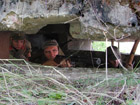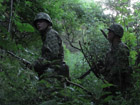|
||||
|
The Battle of the Treasury Islands was fought between 27 October and 12 November 1943 between Allied and Japanese forces. The allied invasion was codenamed Operation Goodtime. The operation, in conjunction with Operation Blissful, served to divert the attention of the Japanese 17th Army from the next major Allied target in the Solomon Islands campaign. The success of the operation helped to improve the planning of subsequent landings in the Pacific. Japanese held the island by just a crew of about 250 soldiers. Nevertheless this unit was well entrenched and had good firepower. |
||||
 |
 |
 |
 |
 |
 |
 |
 |
 |
 |
|
|
||||
 |
 |
 |
 |
 |
 |
 |
 |
 |
 |
 |
 |
 |
 |
 |
 |
 |
 |
 |
 |
|
|
||||
 |
 |
 |
 |
 |
|
Japs retreat inland. |
||||
 |
 |
 |
 |
 |
|
The remainder of the Allied force landed in four waves during the following 20 days after the firs landing. On 1 November the flag was raised over the ruins of Falamae, the islands' capital. |
||||
 |
 |
 |
 |
 |
 |
 |
 |
 |
 |
 |
 |
 |
 |
 |
 |
 |
 |
 |
 |
 |
 |
 |
 |
 |
|
11 days later the islands were declared clear of Japanese forces; although Japanese holdouts were sighted in the jungles into January 1944. |
||||
 |
 |
 |
 |
 |
 |
 |
 |
 |
 |
 |
 |
 |
 |
 |
 |
 |
 |
 |
|
|
New Zealand casualties: 40 killed and 145 wounded. United States casualties: 12 killed and 29 wounded. 205 Japanese soldiers were killed by 12 November, the figure rising to 223 by the end of the month. 8 Japanese soldiers were taken prisoner.
|
||||
 |
 |
 |
 |
|
